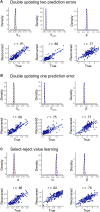Computational mechanisms underlying latent value updating of unchosen actions
- PMID: 37862419
- PMCID: PMC10588947
- DOI: 10.1126/sciadv.adi2704
Computational mechanisms underlying latent value updating of unchosen actions
Abstract
Current studies suggest that individuals estimate the value of their choices based on observed feedback. Here, we ask whether individuals also update the value of their unchosen actions, even when the associated feedback remains unknown. One hundred seventy-eight individuals completed a multi-armed bandit task, making choices to gain rewards. We found robust evidence suggesting latent value updating of unchosen actions based on the chosen action's outcome. Computational modeling results suggested that this effect is mainly explained by a value updating mechanism whereby individuals integrate the outcome history for choosing an option with that of rejecting the alternative. Properties of the deliberation (i.e., duration/difficulty) did not moderate the latent value updating of unchosen actions, suggesting that memory traces generated during deliberation might take a smaller role in this specific phenomenon than previously thought. We discuss the mechanisms facilitating credit assignment to unchosen actions and their implications for human decision-making.
Figures





Similar articles
-
A Normative Account of Confirmation Bias During Reinforcement Learning.Neural Comput. 2022 Jan 14;34(2):307-337. doi: 10.1162/neco_a_01455. Neural Comput. 2022. PMID: 34758486 Free PMC article.
-
Devaluation of Unchosen Options: A Bayesian Account of the Provenance and Maintenance of Overly Optimistic Expectations.Cogsci. 2020 Jul-Aug;42:1682-1688. Cogsci. 2020. PMID: 34355220 Free PMC article.
-
Abstract inference of unchosen option values.Eur J Neurosci. 2020 Feb;51(3):909-921. doi: 10.1111/ejn.14577. Epub 2019 Oct 23. Eur J Neurosci. 2020. PMID: 31518460
-
Lights, camembert, action! The role of human orbitofrontal cortex in encoding stimuli, rewards, and choices.Ann N Y Acad Sci. 2007 Dec;1121:254-72. doi: 10.1196/annals.1401.036. Epub 2007 Sep 13. Ann N Y Acad Sci. 2007. PMID: 17872386 Review.
-
The computational roots of positivity and confirmation biases in reinforcement learning.Trends Cogn Sci. 2022 Jul;26(7):607-621. doi: 10.1016/j.tics.2022.04.005. Epub 2022 May 31. Trends Cogn Sci. 2022. PMID: 35662490 Review.
Cited by
-
Flexible gating between subspaces in a neural network model of internally guided task switching.bioRxiv [Preprint]. 2024 Jun 10:2023.08.15.553375. doi: 10.1101/2023.08.15.553375. bioRxiv. 2024. Update in: Nat Commun. 2024 Aug 1;15(1):6497. doi: 10.1038/s41467-024-50501-y. PMID: 37645801 Free PMC article. Updated. Preprint.
-
Flexible gating between subspaces in a neural network model of internally guided task switching.Nat Commun. 2024 Aug 1;15(1):6497. doi: 10.1038/s41467-024-50501-y. Nat Commun. 2024. PMID: 39090084 Free PMC article.
-
The more random people's preference judgments are, the more they explore in gambling tasks.BMC Psychol. 2024 Dec 20;12(1):766. doi: 10.1186/s40359-024-02252-0. BMC Psychol. 2024. PMID: 39707509 Free PMC article.
-
Cognitive psychology: computing the value of the choices we do not make.Commun Psychol. 2024 Mar 2;2(1):17. doi: 10.1038/s44271-024-00064-x. Commun Psychol. 2024. PMID: 39242742 Free PMC article.
-
Value Estimation versus Effort Mobilization: A General Dissociation between Ventromedial and Dorsomedial Prefrontal Cortex.J Neurosci. 2024 Apr 24;44(17):e1176232024. doi: 10.1523/JNEUROSCI.1176-23.2024. J Neurosci. 2024. PMID: 38514180 Free PMC article.
References
-
- R. S. Sutton, A. G. Barto, Introduction to Reinforcement Learning (MIT Press, 1998), vol. 135.
-
- S. Wang, S. F. Feng, A. M. Bornstein, Mixing memory and desire: How memory reactivation supports deliberative decision-making. Wiley Interdiscip. Rev. Cogn. Sci. 13, e1581 (2022). - PubMed
-
- A. Tversky, I. Simonson, Context-dependent preferences. Manage. Sci. 39, 1179–1189 (1993).
-
- D. E. Bell, Regret in decision making under uncertainty. Oper. Res. 30, 961–981 (1982).
MeSH terms
LinkOut - more resources
Full Text Sources
Other Literature Sources

